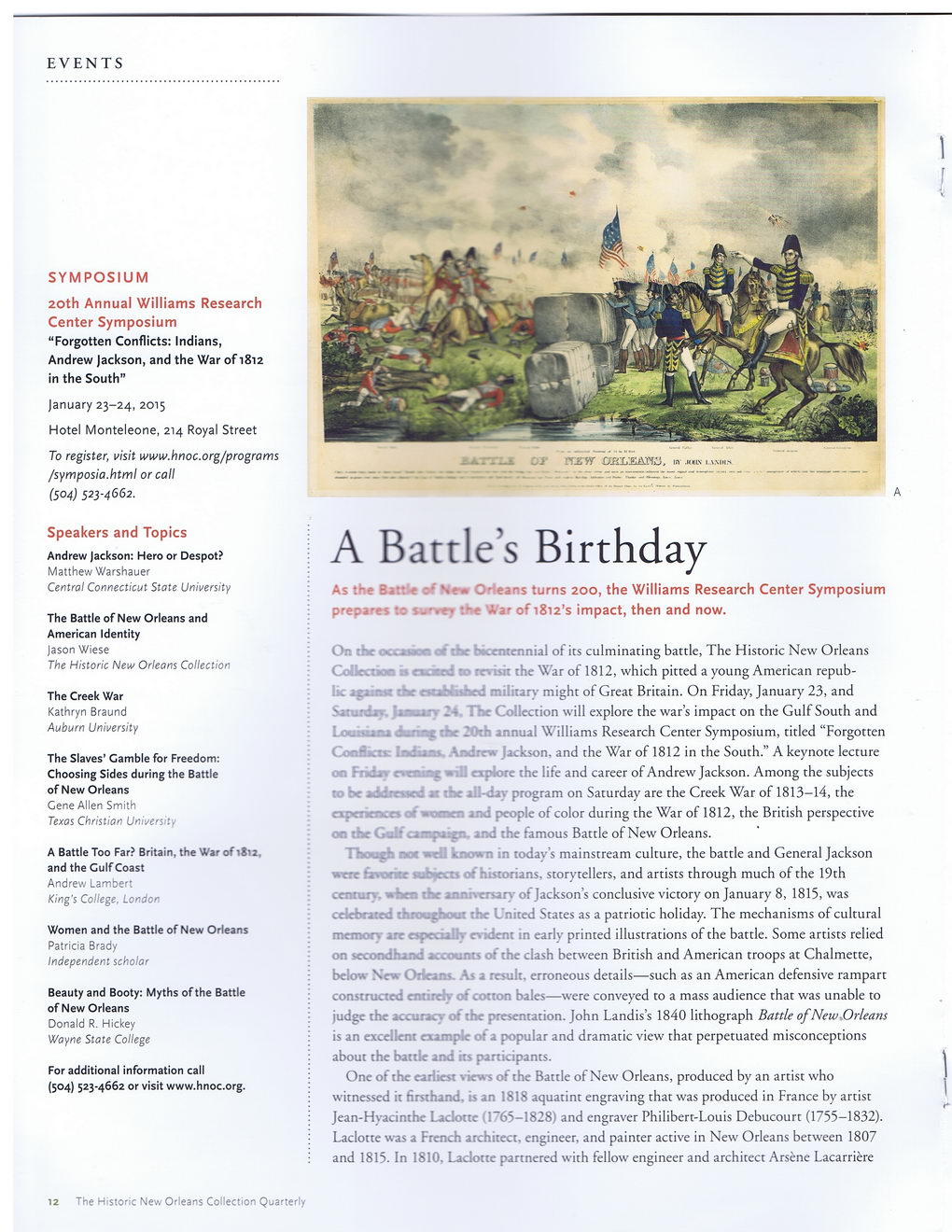This text was obtained via automated optical character recognition.
It has not been edited and may therefore contain several errors.
EVENTS SYMPOSIUM 20th Annual Williams Research Center Symposium “Forgotten Conflicts: Indians, Andrew Jackson, and the War of 1812 in the South” January 23-24, 2015 Hotel Monteleone, 214 Royal Street To register, visit www.hnoc.org/programs /symposia.html or call (504) 523-4662. Speakers and Topics Andrew Jackson: Hero or Despot? Matthew Warshauer Central Connecticut State University The Battle of New Orleans and American Identity Jason Wiese The Historic New Orleans Collection The Creek War Kathryn Braund Auburn University The Slaves’ Gamble for Freedom: Choosing Sides during the Battle of New Orleans Gene Allen Smith Texas Christian University A Battle Too Far? Britain, the War of 1812, and the Gulf Coast Andrew Lambert King's College, London Women and the Battle of New Orleans Patricia Brady Independent scholar Beauty and Booty: Myths of the Battle of New Orleans Donald R. Hickey Wayne State College For additional information call (504) 523-4662 or visit www.hnoc.org. 12 The Historic New Orleans Collection Quarterly rrjrw r?B-r.-inAW,,i, m .oix i.amh*. ■ ' A A Battle’s Birthday As V-. - - ? turns 200, the Williams Research Center Symposium p-• of i8i2’s impact, then and now. O^- - . ■ ■ ennial of its culminating battle, The Historic New Orleans C~ —vim the War of 1812, which pitted a young American repub- : ......... rniliiary might of Great Britain. On Friday, January 23, and k ’ ^ Collection will explore the war’s impact on the Gulf South and 1 c 'Ojh .annual Will iams Research Center Symposium, titled “Forgotten ' j—a Jackson, and the War of 1812 in the South.” A keynote lecture ~ . :re the life and career of Andrew Jackson. Among the subjects -c^v program on Saturday are the Creek War of 1813-14, the i---j people of color during the War of 1812, the British perspective -■ -- ir-j ihe famous Battle of New Orleans. : * -a r ‘*1 today’s mainstream culture, the battle and General Jackson Dorians, storytellers, and artists through much of the 19th -iry of Jackson’s conclusive victory on January 8, 1815, was • ‘ fSiHjt ;h= L'nited States as a patriotic holiday. The mechanisms of cultural rr. r cv^dsnt in early printed illustrations of the battle. Some artists relied or. wo-"'".-!'.. ...i of the clash between British and American troops at Chalmette, bekr. Nc C.'-rani- As a result, erroneous details—such as an American defensive rampart constructed ennrrh oi cotton bales—were conveyed to a mass audience that was unable to judge the ^ ihr presentation. John Landis’s 1840 lithograph Battle ofNewJDrleans is an exce'lent example of a popular and dramatic view that perpetuated misconceptions about the battle and its participants. One of the es-H“s: views of the Battle of New Orleans, produced by an artist who witnessed it firs:hjr<d, is an 1818 aquatint engraving that was produced in France by artist Jean-Hvacinthe Lackxte \ 1765-1828) and engraver Philibert-Louis Debucourt (1755-1832). Laclotte was a French architect, engineer, and painter active in New Orleans between 1807 and 1815. In 1810, Laclotte partnered with fellow engineer and architect Arsene Lacarriere

New Orleans Quarterly 2015 Winter (14)